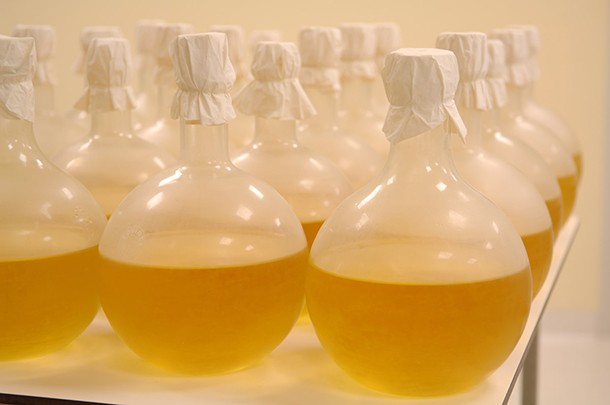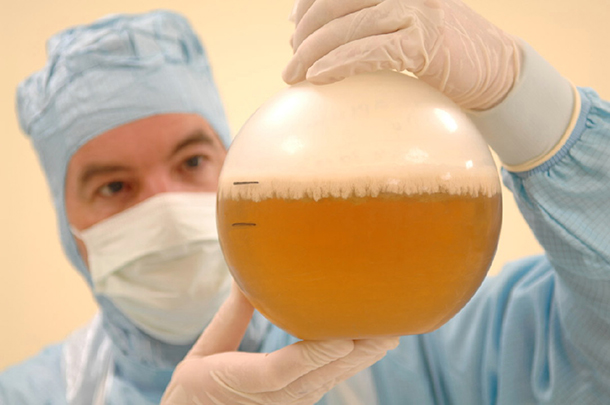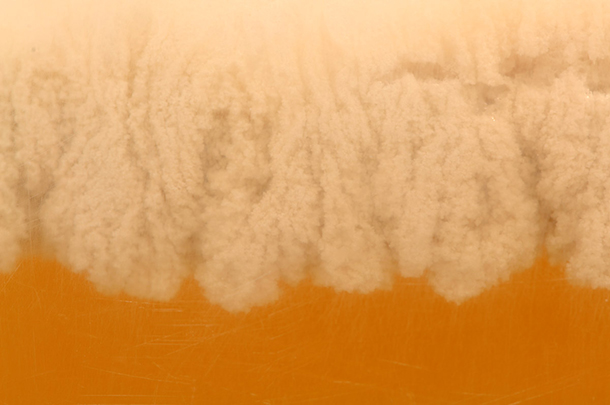Home \ Knowledge Hub \ Focus on \ Focus On… Bovine Tuberculosis: Production of bovine and avian tuberculin at Serumwerk Memsen, WDT


01 May 2019
Focus On… Bovine Tuberculosis: Production of bovine and avian tuberculin at Serumwerk Memsen, WDT
SHARE

DR PETER SCHAUFUSS
Veterinarian, Specialist in Microbiology, Head of Production, Serumwerk Memsen, WDT, Germany; Dr Ursula Groner, Veterinarian, Serumwerk Memsen, WDT, Germany
Here we present Dr Peter Schaufuss, Veterinarian, Specialist in Microbiology, Head of Production, Serumwerk Memsen, WDT, Germany; Dr Ursula Groner, Veterinarian, Serumwerk Memsen, WDT, Germany, in interview with the Intergovernmental Veterinary Health team, MSD Animal Health.
John Atkinson (JA): I know bovine tuberculosis (bTB) is a major concern for countries, but what causes it?
Dr Peter Schaufuss (PS): bTB is one of the major infectious diseases in cattle and other mammalians caused by Mycobacterium bovis or M. caprae. Both species are part of the Mycobacterium tuberculosis Complex (MTC). Farm animals, wildlife populations, as well as humans could be infected with these bacteria. Infections of M. bovis or M. caprae can be transmitted either through respiration or by ingestion. Since the generation time of these bacteria is up to 20 hours, it can take months for clinical signs to develop.
JA: Is tuberculosis in poultry caused by the same organisms?
PS: No. M. avium ssp. avium is the causative agent of tuberculosis in poultry, pigeons, and other kinds of birds. The species belongs to the Mycobacterium avium intracellulare scrofulaceum (MAIS)-Complex.
Marta Nowak (MN): What is the best test to identify bTB?
Dr Ursula Groner (UG): The single intradermal tuberculin test has been used for decades now. There are a number of versions of the test used for routine screening of cattle for bTB by different countries, but the basic principle is the same. The test detects a delayed-type hypersensitivity reaction to the intradermal injection of tuberculin.
The tuberculin test is the international accepted gold standard, and is still the most robust tool for the diagnosis with infections by M. bovis. Its overall accuracy, robustness, and relative simplicity were demonstrated in several field evaluations conducted throughout the world.
JA: So how does the tuberculin test actually work?
UG: Mycobacteria of the Mycobacterium tuberculosis Complex are intracellular pathogens, infecting their hosts via mucosal structures; the most common port of entry is the lung. Infections with intracellular bacteria are accompanied by a delayed-type hypersensitivity (DTH), which expresses itself after local administration of soluble antigens (eg, tuberculin) as a delayed-tissue reaction, mediated by T cells and affected by macrophages. This is the principle of the skin test in cattle and other animals. The test is performed by intradermal injection of 0.1 mL of bovine and/or avian tuberculin. In TB-positive cattle, injection of bovine tuberculin leads to a swelling and local inflammation of the skin. The thickness of the skin is measured with a cutimeter. Avian tuberculin is used as a control against unspecific reactions.
JA: What strains do you use in the production of your tuberculin products?
PS: M. bovis strain AN5 and M. avium strain D4 are used as standard bacteria for the production of veterinary tuberculin tests. As the strains are not commercially available, we established our own seed lot system for both strains, Bovine and Avian. Lyophilised master and working seeds are stored under controlled conditions. The identities of strain AN5 and strain D4 were verified by an independent reference laboratory. M. bovis strain AN5 seed material was identified by spoligotype pattern technique (spacer oligonucleotide typing) and by Mycobacterial interspersed repetitive units–variable number of tandem repeats (MIRU-VNTR) typing, the seed material of M. avium strain D4 was identified by multilocus sequence analysis (MLSA).

MN: Can you tell us a bit about how you grow tuberculins?
PS: It is a complex and a very interesting process because M. bovis is an extremely delicate and demanding organism. We reconstitute the freeze-dried strains with physiological saline solution, inoculate this solution on a standardised Loewenstein-Jensen medium, which is incubated at 37°C for several weeks. We control the growth on this medium on each working day. Once the colonies are grown in the right manner, some colonies are transferred onto a surface of a liquid synthetic TB medium in round-bottom flasks (Fig. 1). It is most important that the colonies swim on top of the medium, creating a fine and thin film on the surface. Submersed cultures, or rough growing cultures, do not produce tuberculin and are not usable for production. Thus, the morphology of the cultures is very important and is also controlled on each working day.

MN: Then what happens?
PS: After approximately 4 weeks, a thin film is growing on the surface of the liquid medium. Some small pieces of the culture are again transferred into another set of round-bottom flasks with synthetic medium. Usually, a series of up to three inoculations of preparatory cultures are necessary to adapt the cultures to the liquid medium and to obtain floating growth on the surface of the medium as a white top layer (Fig. 2). During the growth period, metabolic products of the bacteria are excreted into the medium. The active part of the tuberculin are proteins with a molecular weight between 23,500 and 44,000 daltons. Up to 400 production flasks are incubated in an incubation room until a sufficient mass of bacteria is obtained (Fig. 3).

MN: Is there a step in this process that you would call particularly challenging? And why?
PS: In this time-consuming procedure, every single flask is prepared manually under a microbiological safety cabinet. Furthermore, the flasks are controlled for growth and contamination on each working day. Finally, the cultures are inactivated by heat and the bacterial biomass is separated from the water-soluble fractions by gross filtration. The tuberculin-containing fluid is clarified and sterilised by further filtration.
JA: How has the production of tuberculin changed over time?
PS: In earlier times we isolated tuberculin, the active fraction of the filtrate mainly consisting of protein, by precipitation with 4% trichloroacetic acid (TCA). The precipitated tuberculin purified protein derivative (PPD) was separated by centrifugation, washed twice with a 1% TCA solution, followed by another washing step with a buffer solution. The washed precipitate was dissolved in phosphate-buffer saline solution. The result was called “concentrated PPD” and was used for subsequent dilutions. This method was time-consuming, and this production method is no longer used here.
JA: What did you do to advance the production method?
PS: We developed a different purification method: cross-flow filtration. Production of tuberculin from culture filtrates of M. bovis or M. avium by ultrafiltration is considered to be a modern and reliable alternative compared to TCA-precipitation as no biohazardous chemicals are used. Furthermore, it is possible to separate proteins exactly by their defined molecular weight. Using the cross-flow method, the risk of protein denaturation is very low. The cross-flow technique is a dynamic filtration in which the fluid flows tangentially over the membranes. The main stream prevents clogging of the membrane; a part of the stream passes the membrane and can be separated as filtrate. The system can be validated and leads to reproducible results. We use the setup under clean-room class B conditions. Further, the tuberculin concentrates are tested for potency in previously sensitised guinea pigs. Based on the results of this test, the concentrates are diluted to the appropriate potency.
JA: Thank you for taking the time today to talk to us and explain the main steps in the production of tuberculin. I am sure that it will be very interesting to our audience, especially for those involved in the control of bTB. It is clear that whilst the process is complex and time-consuming, it is essential that each step is followed to produce the required high-quality product. We are delighted that you have given us a glimpse into what goes on behind the scenes in the fight against bTB.
Further information on bovine tuberculosis and tuberculin can be found at:
http://www.emergence-msd-animal-health.com/Resources/#Tuberculin
http://www.oie.int/fileadmin/Home/eng/Media_Center/docs/pdf/Disease_cards/BOVINE-TB-EN.pdf
http://www.oie.int/en/animal-health-in-the-world/animal-diseases/Bovine-tuberculosis/
WDT partner with MSD Animal Health to produce Intertest™ Bovine PPD Tuberculin and Avian PPD Tuberculin.
DR PETER SCHAUFUSS
Veterinarian, Specialist in Microbiology, Head of Production, Serumwerk Memsen, WDT, Germany; Dr Ursula Groner, Veterinarian, Serumwerk Memsen, WDT, Germany
The views and opinions expressed in this article are those of the author.

